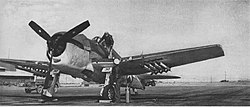Grumman F6F Hellcat
The F6F Hellcat was a United States Navy fighter aircraft made by Grumman during World War II. It first flew in 1942 and was introduced in 1943. It was supposed to be a little bit better than the F4F Wildcat, but became a big improvement. It was more powerful and could turn better. It was made to fight the Japanese A6M Zero. It was able to take off of aircraft carriers. It was also used by the navy as a "night fighter", with radar so it could fly at night. During the war, it had the most aces fly it. It was retired in 1954.
| F6F Hellcat | |
|---|---|
| Grumman F6F-3 Hellcats in tricolor camouflage[1][Note 1] | |
| Role | Carrier-based fighter aircraft |
| National origin | United States |
| Manufacturer | Grumman |
| First flight | 26 June 1942 |
| Introduction | 1943 |
| Retired | 1960 Uruguayan Navy[2] |
| Primary users | United States Navy United States Marine Corps Royal Navy French Navy |
| Produced | 1942–45 |
| Number built | 12,275 |
| Unit cost | $35,000 in 1945[3] |
The Hellcat was a rival to the Vought F4U Corsair and had more aerial victories and participated in more missions. The F6F was equipped with Browning Machine Guns, and had external fuel tanks for longer range. It had the same engine as the F4U. The armor of the Hellcat was better than that on other aircraft.
Grumman F6F Hellcat Media
F6F-3 aboard USS Yorktown has its "Sto-Wing" folding wings deployed for takeoff (circa 1943-44).
A U.S Marine inspects a Japanese-captured F6F-5 in Yokosuka in September 1945.
A section of Fleet Air Arm Hellcat F Mk.Is of 1840 Squadron in June 1944
A F6F-5K Hellcat target drone is shot down by the heavy cruiser USS Saint Paul, in 1954.
XF6F-2 showing the later R-2800-21 installation with Birman turbocharger (1943)
References
- ↑ "U.S. Naval Aircraft Marking." Archived 2010-11-15 at the Wayback Machine U.S. Naval Historical Center. Retrieved: 11 March 2008.
- ↑ "Uruguayan Navy." Archived 11 June 2011 at the Wayback Machine aeroflight. Retrieved: 27 May 2012.
- ↑ Ferguson 2005, pp. 149–175.
Notes
- ↑ The insignia red outline around the national markings indicate that this picture was taken circa June–September 1943.
| Wikimedia Commons has media related to Lua error in Module:Commons_link at line 62: attempt to index field 'wikibase' (a nil value).. |








